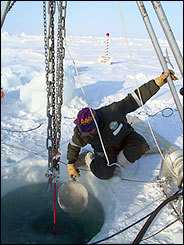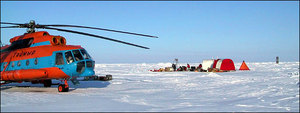
|
| ©New York Times |
| Broken bolts stalled efforts to retrieve instruments through a hole in the Arctic ice |
Six leading polar oceanographers and marine engineers huddled around the broken winch next to a manhole-size opening that had been melted the day before through the nine-foot-thick ice, staring at the line dangling in the slushy green water.
If they could find no replacements for a few dollars' worth of fasteners, the winch would be useless scrap, the instruments might be stuck in the sea, and the replacements for the coming year would not be deployed.
Such is the craft of science at the ends of the earth - particularly this end of the earth, where the pole sits over a 14,000-foot-deep ocean cloaked in shifting ice.
Hand-held satellite navigation devices and telephones provide a welcome sense of connectedness. But in a place where sea-ice runways crack apart, even the simplest setback can threaten ambitious research and, potentially, the researchers themselves.
The winch problem was just one of myriad challenges, large and small, that confronted scientists who recently ventured north to decipher disturbing changes in the polar ice, ocean and atmosphere.
The anchored instrument array was the centerpiece of the North Pole Environmental Observatory, a five-year $4 million effort to establish the first year-round record of conditions here.
Such a portrait was much needed, given that polar ice had been retreating record distances in summertime over the last decade and that sharp warming around the Arctic perimeter was prompting serious talk of an ice-free polar sea by midcentury. The changes could be a temporary shift in the range of normal variation. Or they could be an early result of global warming from rising concentrations of heat-trapping greenhouse gases.
But this climate puzzle could only be solved at the pole itself, where pirouetting ice floes cloak the ocean in crackled whiteness and make it impossible to establish anything more than a fleeting foothold.
Unlike almost anywhere else on the planet, this environment required a research team that combined the intellectual power of scientists with the brute strength of furniture movers, the wile of backcountry mechanics, the courage (or recklessness) of extreme athletes and the willingness to carry a shotgun to ward off polar bears.
Over three weeks in late April and early May, the project leader, Dr. Jamie Morison, an oceanographer at the University of Washington, and 14 colleagues from the West Coast and Japan brought this suite of skills to the Arctic as they successfully - albeit sometimes just barely - completed the fourth year of the observatory mission.
Spring is the only time of year when daylight is constant but the ice is not yet warmed so much that its surface turns to knee-deep slush.
Eventually, in their offices and labs in Seattle and Tokyo, the scientists will sift figures and report their findings in learned journals. Now, though, they were nursing bashed and frost-split knuckles and struggling with countless mechanical and logistical crises.
Working nearly around the clock in the constant daylight, they lived on power naps and stray bits of food, including juice boxes whose contents chilled to the consistency of a Slurpee and, in one case, a shared day-old salmon sandwich rendered crunchy by the frigid air.
Their mission was to measure vagaries in the ice, the influx of heat from the sun and from warm currents deep in the sea and the chemistry and dynamics of water layers from the surface on down.
They would swap the old and new underwater instrument chains and install three drifting instrument-studded buoys in the sea ice around the pole. Several scientists would hopscotch by plane and helicopter from northernmost Canada toward the encampments, measuring ocean and ice conditions along the way.
As a whole, the project is a work in progress, with problems and successes one year leading to modifications the next.
The goal, Dr. Morison said, is eventually to devise a permanent means of monitoring changes in the ice and the waters flowing beneath it from the Pacific, the Atlantic, and the great rivers of Siberia and Canada.
The work could improve weather forecasts and clarify whether a warming world, by unbalancing the Arctic system, could lead to calamitous climate changes around the Northern Hemisphere.
"We're trying to establish a pretty much automated way of keeping track of how the Arctic Ocean and sea ice are changing, and they've changed quite a bit in the last 15 years," Dr. Morison said.
The work is "about the toughest kind of oceanography you can imagine," said Dr. Neil R. Swanberg, program director for Arctic system science for the National Science Foundation, which is financing the observatory project.
It is vital because the pole is an ideal place to study whether the changes afoot are a wiggle or the first stage of a sharp turn, Dr. Swanberg said, adding, "The North Pole observatory is right on the interface where a lot of these things are happening."
Now if someone could just find some bolts.
Dr. Morison and five members of his team worked on the winch, debating options as their flash-frozen exhalations built white frost on their beards.
"There's three good mechanics here, so let's figure this out," said Eric Boget, one of the divers who had snared the mooring 12 hours earlier and who is an ocean engineer at the University of Washington.
The winch was perhaps the simplest piece of equipment in the two-tent encampment. But like everything else in sight, from the soot-stained Russian helicopter to the Iridium satellite telephones, it had to function for the project to succeed.
As the winch was dissected, the second diver, Jim Osse, who is also an ocean engineer, scooped thickening "grease ice" from the hole. The slush was the sea's way of announcing that it was preparing to close the portal as the 28-degree water was chilled by the 15-below-zero air.
Jim Johnson, an engineer from the university who helped design the instrument string, sat at a table nearby, frowning as he entered notes on the new problems in his log with a pencil. (Ink freezes.)
Even in a place where time loses all meaning, with today starting in March and ending in September, time was the enemy. For one thing, no one knew how long the Russian helicopter crew would be willing to wait. The tiny camp here was set up for just four people. There were six extra people, and before long they would have to be ferried back to Camp Borneo, a commercial base camp set up 60 miles from the pole each spring by Russian and French entrepreneurs.
For now, the copter pilot and crew idly smoked and snapped pictures of one another near a whimsical "North Pole Was Here" sign set up by the mooring team (a tribute to the fact that the ice camp was drifting 400 yards an hour). At any moment, they could be radioed to pick up the dozen ski trekkers who were nearing the pole or to ferry six Muscovite skydivers who were arriving soon on a plane from Siberia.
At any moment, an open-water crack could split the encampment, just as one, in late March, sundered the first runway built for Borneo just three hours after two 20-ton Russian airplanes lifted off. Or colliding floes could lift a pressure ridge like one that crushed the snowmobile hut of an expedition near Alaska years earlier.
For the scientists at the winch, many of whom had made 12 or more trips to the Arctic, those are just some reasons the North Pole is little studied. Science here is mainly a grueling process of packing, loading, getting there, unloading, unpacking, waiting, rushing, breaking things, repairing things and always improvising.
There is the cold, which for this expedition rarely rose above 10 below zero and can cause liquid crystal displays on instruments and laptops to solidify.
Then there is the distance. From Camp Borneo, it is a two-and-a-half-hour 510-mile flight to the northernmost permanent human outpost in the world, a Canadian military base called Alert. Distance translated into a lack of vital things.
Some scientists were stranded in a marginally heated tent at the runway, miles from all the camps, when helicopter fuel ran short after storms in Siberia grounded Russian supply planes.
In sharp contrast to the South Pole, where researchers from 29 countries efficiently operate out of a host of permanent research stations, here scientists sat for hours then worked in frenzied bursts on the fast-changing icescape. One described it as "adrenalin moments surrounded by slabs of time."
Dr. Timothy D. Stanton, an oceanographer from the Naval Postgraduate School in Monterey, Calif., went 18 hours without a sip of water on the day when he hiked a half-mile from the Borneo runway to install his "baby," an automated $40,000 buoy designed to measure small amounts of heat flowing through the waters beneath the ice. The information could help improve computer models of the polar climate.
It took 10 hours for Dr. Stanton to drill a foot-wide hole in the ice with an auger and wrestle the buoy and its antennas and "top hat" dome into place. Then he had to test its systems and make sure that it could send the information back to Monterey as it drifted past Greenland in the months to come.
Out on the ice, a distant dot from the runway, Dr. Stanton plugged his laptop into the buoy and gave it a farewell checkup. And there was no sign of life.
The buoy, which had traveled 5,000 miles on two bumpy airplane rides and had then been hauled behind the old bulldozer over the rough ice, might be dead. Perhaps the fault lay in an adjustment that Dr. Stanton had tried a few days earlier. He had modified a microchip in the buoy innards and then hastily had to undo that repair.
"These are showstopper things I had to resolve sort of here and now," he said. "You couldn't say, 'Well, I'll sleep on it.' "
Dr. Stanton ferreted out the fault and soldered new connections. He was nearly euphoric when he was finally able to trek back to the tent near the runway and found that Dean Stewart, an engineer, had fired up a stove and produced a pot of drinking water by melting ice.
True euphoria struck a week later, when Dr. Stanton was back in Monterey and saw figures from the polar waters flowing in regularly from the buoy.
"It calls in twice a day, like a good child," he said in a recent e-mail message.
But that would be later.
For now, Dr. Stanton huddled on the ice with the divers and Dr. Morison and the balky winch and the broken bolts, trying to help.
Dr. Stanton, Dr. Morison and some visitors had to leave when the helicopter fired up its jet engines to head to Borneo. They were following one of the three axioms of Arctic life that Mr. Osse had listed earlier: never pass up a meal, never pass up a shower and never pass up a flight south.
In the end, the divers and engineers who stayed behind extracted three identical bolts from the brake on the opposite side of the device, and they fit perfectly in place of the ones that had fractured.
From a grab bag of fasteners, the scientists found others to replace the ones that had been scavenged.
Someone fired up the generator, the winch spun, and the strand of instruments with their yearlong lode of data rose from the steaming, slushy hole.




Reader Comments
to our Newsletter